Sights around Nevsky Prospekt
Around Ligovsky Prospekt
Arctic and Antarctic Russian State Museum
- 24A Ulitsa Marata
- Vladimirskaya, Ploschad Vosstania
- http://www.polarmuseum.ru/
- (Weekends: 10:00 - 18:00). Closed on Mondays and Tuesdays.
The Arctic and Antarctic Russian State Museum was founded in 1930 to detail Soviet scientific expeditions to the Arctic, Antarctic and the polar regions of Russia, including the Northern Sea Route. It was officially opened in 1933 in the early 19th century building of St Nicholas's Church, which was closed in 1931. On display are various models of icebreakers, ships and polar stations used in researching the earth's polar regions, as well as many drawings made on such research… Read more »
Exaltation of the Cross Cossack Cathedral
- 128 Ligovsky Prospekt
- Ligovsky Prospekt, Obvodny Kanal
The Exaltation of the Cross Cossack Cathedral started its life as a wooden church dedicated to the Resurrection of St John the Baptist which was built between 1710 and 1712 for the local population of coachmen. By the 1740s there were calls to build a new stone church here and work was completed in 1751. The new baroque-style church was dedicated to the Exaltation of the Cross. In 1938 the church was closed, but was reopened after the fall of the Soviet Union. In 2000 it was… Read more »
Lev Gumilev Memorial Apartment-Museum
- apartment 4, 1/15 Ulitsa Kolomenskaya
- Ploschad Vosstania, Vladimirskaya, Ligovsky Prospket
- http://www.akhmatova.spb.ru/muzey-lva-nikolaevicha-gumileva.77.html
- 11:00 - 18:00. Closed on Mondays.
Lev Gumilev was a Soviet historian and anthropologist and the son of poets Nikolai Gumilev and Anna Akhmatova. His father was arrested and executed by the Cheka in 1921 and Lev spent many years as an inmate of the Gulag. After the death of Stalin, Gumilev was released and started working at the Hermitage and began studying the people of the Caucasus, especially the ancient Khazar tribe. Gumilev went on to introduce a controversial concept known as the 'passionarity' of ethnic… Read more »
Around Liteyny Prospekt
Anna Akhmatova Museum in the Fountain House
- 34 Naberezhnaya Reki Fontanki (entrance from Liteyny Prospekt)
- Mayakovskaya
- http://en.akhmatova.spb.ru/
- 10:30 - 18:30 (Wednesdays: 12:00 - 20:00). Closed on Mondays and public holidays.
The Anna Akhmatova Museum in the Fountain House was opened in 1989 on the 100th anniversary of the birth of the famous Soviet poet. It was opened in the 18th century Sheremetyev Palace, which is more commonly known as the Fountain House and is where Akhmatova once live. The museum has collected and now displays various items connected with Akhmatova and her work. To get to the museum you should walk to 53 Liteyny Prospekt and go through the arch to the gardens where you will… Read more »
Museum of Applied Art
- 13-15 Solyanoi Pereulok
- Chernyshevskaya
- http://www.stieglitzmuseum.ru/
- 11:00 - 17:00. Closed on Sundays, Mondays and in August.
St Petersburg's Museum of Applied Art was founded in 1876 as part of the Aleksandr von Stieglitz Technical Drawing School, which today is the St Petersburg State Art and Industrial Academy. The building of the museum itself is one of the main highlights. Its central hall stands under a glass roof and other smaller rooms are decorated in various historical styles. The actual exhibits themselves include thousands of examples of furniture, traditional Russian tiled ovens,… Read more »
Museum of Music (Sheremetev Palace)
- 34 Naberezhnaya Reki Fontanki
- Mayakovskaya
- http://www.theatremuseum.ru/
- 11:00 - 19:00 (Wednesdays: 13:00 - 21:00). Closed on Tuesdays and the last Wednesday of the month.
St Petersburg's Museum of Music is situated in the former palace of the Sheremetevs, which was built in the mid-18th century on land granted to the noble family by Peter the Great. It remained in the hands of the Sheremetevs until the Revolution when it was turned into a museum of Russian nobility. In 1989 it was transferred to the State Museum of Theatrical and Musical Culture and turned into a museum of music, displaying hundreds of musical instruments. The state rooms of the… Read more »
Nikolai Nekrasov Apartment-Museum
- 36 Liteyny Prospekt
- Mayakovskaya, Chernyshevskaya
- http://www.museumpushkin.ru/info/apartment-museum-nekrasov.html
- 10:30 - 18:00. Closed on Monday, Tuesdays and the last Friday of the month.
In 1946 the Nikolai Nekrasov Apartment-Museum was opened in the apartment where the Russian poet and author lived from 1857 until his death in 1877. It was in this apartment that Nekrasov edited the Sovremmenik and Otechestvennye Zapiski journals and entertained Russian cultural greats such as Dostoevsky, Ostrovsky, Saltykov-Schedrin, Tolstoy and Turgenev. The museum has displays on the life and work of Nekrasov, as well as on his contemporaries, and in 1985 the room of Ivan Panaev… Read more »
Ss Simeon and Anna's Church
- 48 Ulitsa Mokhovaya
- Mayakovskaya
Ss Simeon and Anna's Church which is located on the corner of Ulitsa Belinskogo and Ulitsa Mokhovaya, just off Liteyny Prospekt, is one of the oldest surviving churches in St Petersburg. It was built between 1731 and 1734 in the architecture style known as Petrine baroque. Before this a wooden church stood here. In 1938 the church was closed and later it was used to hold a meteorology museum. It was returned to the Orthodox Church in 1991 and re-consecrated in 1995. Read more »
St Pantaleon's Church
- 2A Ulitsa Pestelya
- Chernyshevskaya
The pretty red and white St Pantaleon's Church was built between 1735 and 1739. It was originally built in the architectural style known as Petrine baroque, but later mid-19th century work gave it some empire features. In 1936 the church was closed and it was later used to hold a museum on the defence of the Hanko Peninsular during the Second World War. It was returned to the Orthodox Church in 1991 and reopened for worship in 1994. Read more »
State Memorial Museum of the Defence and Siege of Leningrad
- 9 Solyanoi Pereulok
- Chernyshevskaya
- http://www.blokadamus.ru/
- 10:00 - 17:00 (Wednesdays: 12:30 - 21:00). Closed on Tuesdays and the last Thursday of the month.
One history museum in St Petersburg which is really worth visiting is the State Memorial Museum of the Defence and Siege of Leningrad which details the immense suffering of Leningrad citizens during dark days of the Second World War when the city was encircled by Nazi troops and cut off from the rest of the country. It was opened in 1946 in the building complex known as the Solyanoi Gorodok (Salt Town) as this area was once used for storing salt. However in 1953 the museum was… Read more »
Transfiguration of the Saviour Cathedral
- 1 Preobrazhenskaya Ploschad
- Chernyshevskaya
- http://www.preobragensky.ru/
Standing in the centre of Preobrazhenskaya Ploschad (Transfiguration Square) is the Transfiguration of the Saviour Cathedral. The current version of the cathedral was built between 1825 and 1829 in the classical style. However the original version was built between 1743 and 1754 on the orders of Empress Elizabeth. During the Soviet period the cathedral remained open, although for a short period of time it was transferred to the Renovationist Church and several of its relics were… Read more »
Around Moskovsky Prospekt

Chesme Church
- 12 Ulitsa Lensoveta
- Moskovskaya
Out of the thousands of Orthodox churches in Russia, one which really stands out due to its unique and striking appearance is St Petersburg Chesme Church. It is known as the Chesme (or Chesmenskaya) Church as it was built between 1777 and 1780 to commemorate Russia's victory over the Ottoman Turks at the Battle of Chesme. Officially the church is known as St John the Baptist's Church at Chesme Palace. The neighbouring Chesme Palace was originally built as a traveller palace to… Read more »
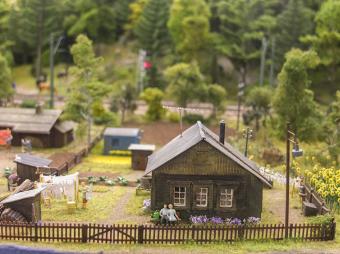
Grand Maket Russia
- 16Л Ulitsa Tsvetochnaya
- Moskovskie Vorota
- http://www.grand-maket.ru/
- 10:00 - 20:00. Daily.
An interesting new sight in St Petersburg is the Grand Maket Russia which is a 800 square metre toy railway set representing the enormous territory of Russia and its various regions. Here in just one room you can see what Russia has to offer from Moscow, St Petersburg, Sochi, the Urals, the Far North and the Far East, which would take a whole lifetime to see in real life. The moving trains are just one of the features of the set, you can also spend hours looking at the models of… Read more »
Monument to the Heroic Defenders of Leningrad
- Ploschad Pobedy
- Moskovskaya
- Museum closed on Wednesdays.
The main monument to St Petersburg's war time role is located on Ploschad Pobedy (Victory Square) at the end of Moskovsky Prospekt on the way to Pulkovo Airport. The monument is dedicated to the "heroic defenders of Leningrad" and was unveiled in 1975 on the 30th anniversary of the end of the war. The main feature is a 48-metre obelisk and an eternal flame surrounded by a circular wall with inscriptions. There are also many statues here of the victims and the heroes in the… Read more »
Moscow Triumphal Gates
- Ploschad Moskovskie Vorota
- Moskovskie Vorota
St Petersburg's Moscow Triumphal Gates are so named as they stand at the beginning of Moskovsky Prospekt and the end of Moskovskoe Shosse (Moscow Highway) which is the main road into the city from Moscow. The gates were installed in 1838 and were designed by architect Vasili Stasov. They were built out of cast iron in the empire style and decorated with various friezes of a military theme. After the Revolution the gates were dismantled and the metal blocks were even used to from… Read more »
Moskovsky Victory Park
- Opposite Ploschad Chernyshevskogo on Moskovsky Prospekt
- Park Pobedy
Moskovsky Victory Park is the largest memorial park in St Petersburg dedicated to the Soviet Victory in the Second World War. It was opened in July 1946 on the sight of a demolished brick factory which was used as a makeshift crematorium during the Siege of Leningrad. Hundreds of thousands of bodies were cremated here. The central alley in the park is known as the Alley of Heroes and it features several busts of heroes of the Soviet Union who came from Leningrad, as well as statues… Read more »
Nikolai Chernyshevsky Monument
- Ploschad Chernyshevskogo
- Park Pobedy
Around two-thirds down Moskovsky Prospekt is Ploschad Chernyshevskogo (Chernyshevsky Square) which features a statue of its namesake - the socialist revolutionary Nikolai Chernyshevsky, who served as a big influence on the thinking of Vladimir Lenin. The statue was unveiled in 1947. Read more »
Pulkovsky Park
- Ploschad Pobedy
- Moskovskaya, Zvyozdnaya
Pulkovsky Park is located just off Ploschad Pobedy, occupying the triangle formed by Pulkoskoe Shosse, Moskovskoe Shosse and Dunaisky Prospekt. In the northern part of the park you can find some pillboxes from the Second World War and in the southern part, around the pond, there is a church ensemble consisting of three churches: St George's Church, St Sergius of Radonezh's Church and the Nativity of Christ Church. All three churches are modern and date from after the fall of the… Read more »
Vladimir Lenin Monument
- Moskovskaya Ploschad
- Moskovskaya
The central square of St Petersburg's Moskovsky District is Moskovskaya Ploschad on Moskovsky Prospekt. Standing on the centre of the square is a rather dramatic statue of Vladimir Lenin, which was unveiled in 1970. The statue is complemented by the giant building of the House of Soviets behind him which was built between 1936 and 1941 in the architectural style known as Stalinist empire. Read more »
Voskresensky Novodevichy Convent
- 100 Moskovsky Prospekt
- Frunzenskaya, Moskovskie Vorota
- novodev.spb.ru/
The first convent in St Petersburg was the Smolny Convent which was founded in 1746 by Empress Elizabeth but this was later dissolved during the reign of Empress Catherine the Great. It was only in 1849, under Emperor Nicholas I, that a convent was reopened in St Petersburg in the south of the city. Like the previous Smolny Convent, it was dedicated to the resurrection ('voskresenie') of Christ and was named the Voskresensky Novodevich ('New Maiden') Convent. The convent was… Read more »
Around Nevsky Prospekt
Aleksandr Nevsky Monument
- Ploschad Aleksandr Nevskogo
- Aleksandra Nevskogo-1
Standing on Ploschad Aleksandr Nevskogo (Aleksandr Nevsky Square) just outside the Aleksandra Nevskogo-1 metro station and the Aleksandro-Nevsky Lavra is unsurprisingly a statue of Aleksandr Nevsky himself. When Peter the Great founded the neighbouring lavra he believed he was establishing it at the site of Nevsky's famous victory over the Swedes at the Battle of the Neva. However historians now believe the battle took place further down the Neva where the River Izhora flows into… Read more »
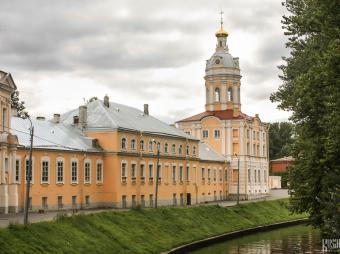
Aleksandro-Nevskaya Lavra
- 1 Naberezhnaya Reki Monastyrki
- Aleksandra Nevskogo-1
- http://www.lavra.spb.ru/
Just behind Ploschad Aleksandr Nevskogo (Aleksandr Nevsky Ploschad) at the very end of Nevsky Prospekt is the Aleksandro-Nevskaya Lavra which is officially known as the Svyato-Troitskaya Aleksandro-Nevskaya Lavra (Holy Trinity St Aleksandr Nevksy's Lavra). It is the main monastery in St Petersburg and only one of two in Russia to hold the title of lavra - the other being the Troitse-Sergieva Lavra in Sergiev Posad. The monastery was founded in 1713 by Peter the Great and… Read more »
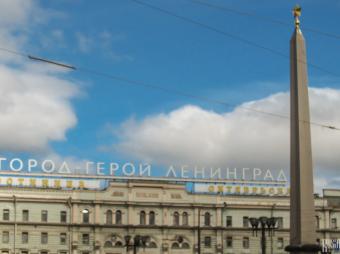
Leningrad Hero-City Obelisk
- Ploschad Vosstania
- Ploschad Vosstania
Just outside Moskovsky Railway Station in the centre of Ploschad Vosstania (Uprising Square) is an obelisk in celebration of St Petersburg's status as a Hero City, which was awarded in 1965 when the city was known as Leningrad. The obelisk was erected in 1985 on the 40th anniversary of the Soviet victory in the war. The words 'Hero-City Leningrad' are written in large letters on top of the building behind the obelisk. Read more »
Moskovsky Railway Station
- 85 Nevsky Prospekt
- Ploschad Vosstania
Moskovsky Railway Station is located in the centre of St Petersburg on the cross roads of two of its main streets - Nevsky Prospekt and Ligovsky Prospekt - and is the main railway station which connects Russia's two principle cities - Moscow and St Petersburg. The closest metro to Moskovsky Railway Station is Ploschad Vosstania which is on the red line (line No. 1). Located 300 metres away is metro Mayakovskaya on the green line (line No.3). The construction of the railway station… Read more »
Our Lady of St Theodore Cathedral
- 1Б Ulitsa Mirgorodskaya
- Ploschad Vosstania, Aleksandra Nevskogo-1
- http://www.feosobor.ru/
Located just off Nevsky Prospekt down Ulitsa Poltavskaya is one of St Petersburg's lesser known cathedrals - the Our Lady of St Theodore Cathedral, which was built between 1911 and 1914 for the 300th anniversary of the House of Romanov. St Theodore was considered the house's patron saint and his icon was especially revered by the imperial family. Although the cathedral dates from the early 20th century it was built in the Rostov style common during the reign of the first Romanov… Read more »
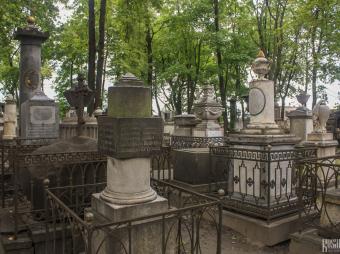
State Museum of City Sculptures (Tikhvinskoe and Lazarevsky Cemeteries)
- 179 Nevsky Prospekt
- Aleksandra Nevskogo-1
- http://www.gmgs.ru
- Necropolises: 09:30-18:00, daily. Church: 11:00 - 17:00, closed on Mondays and Thursdays. Exhibition: 10:00 - 17:00, closed on Thursdays.
The State Museum of City Sculptures was founded in 1932 dedicated to the study, restoration and protection of city sculptures and gravestones and the museum is responsible for the upkeep of many of St Petersburg's most famous sculptures. The museum has several branches around St Petersburg, but the main ones are concentrated within the former territory of the Aleksandro-Nevsky Lavra which was granted to the museum upon its founding. Annunciation Church The Aleksandro-Nevsky… Read more »
Around Ploschad Stachek
Catherinehof Park
- Ulitsa Liflyandskaya
- Narvskaya
Catherinehof (Yekateringof) Park is situated on Yekateringofsky island between Yekateringofka and Tarakanovka rivers. It was founded in 1711 and named in honour of Peter the Great's wife Yekaterina, who later became Empress Catherine I. Peter the Great ordered the building of a two-storey wooden palace here to serve as a travelling palace on route to Peterhof. After the death of Peter and Catherine I, the park became less of an imperial residence and more of a city park. The… Read more »
Epiphany Church
- 2 Ulitsa Dvinskaya
- Narvskaya
Just on the other side of Yekateringofka River from the Catherinehof park is the Epiphany Church on Gutuevsky Island. The church was built between 1889 and 1899 in the Russian revival architectural style, which was popular at the time. Its construction commemorated the survival of Tsarevich Nikolai Aleksandrovich (who later became Emperor Nicholas II) after an assassination attempt while on an official visit to Japan. In 1935 the church was closed and its large central dome was… Read more »
Leonid Govorov Monument
- Ploschad Stachek
- Narvskaya
Standing just in front of the Narva Triumphal Gates is a statue of Leonid Govorov who was a Soviet military commander during the Second World War. Having previously fought in the Winter War between the USSR and Finland, in 1942 he was appointed commander of the Leningrad Front and was entrusted with lifting the Siege of Leningrad. The siege was eventually broken in January 1943 and after this Govorov planned the Soviet counter offensive which liberated the rest of the Leningrad… Read more »
Narva Triumphal Gates
- 1 Ploschad Stachek
- Narvskaya
- http://www.gmgs.ru
- 11:00 - 17:00 (Wednesdays: 14:00 - 20:00). Closed on Mondays, Tuesdays and the last Wednesday of the month.
The Narva Triumphal Gates stand on the centre of Ploschad Stachek which was previously known as Narvarskaya Ploschad (Narva Square) as it marked the entrance into St Petersburg if approaching for the Estonian city of Narva. The original triumphal arch was built out of wood in 1814 to celebrate Russia's victory over Napoleon, but the current version was built between 1827 and 1834. It was designed by the architect Vasily Stasov who was also behind the Moscow Triumphal Gates. Unlike… Read more »
Our Lady of Kazan Church
- 2 Ulitsa Dvinskaya
- Narvskaya
Our Lady of Kazan Church was built between 1904 and 1910 as an embassy-church of the Staroladogozhsky Uspensky Convent in Staraya Ladoga. It was built in the Moscow baroque style with five small domes and included a separate bell tower and gate. In 1935 the church was closed and later used as a sewing and then furniture workshop. In 1989 it was reopened and became an embassy-church of the Spaso-Preobrazhensky Valaamsky Monastery. Read more »
Around Zagorodny Prospekt and Troitsky Prospekt
Dmitri Mendeleev Monument
- outside 19 Moskovsky Prospekt
- Tekhnolohichesky Institut
The Russian chemist Dmitri Mendeleev is most famous for creating the periodic table which is also known as the Mendeleev Table. This statue of him was unveiled in 1932 outside the building of the Bureau of Weights and Measures where Mendeleev once worked (now it is known as the Mendeleev Metrology Institute). Also located nearby is the St Petersburg Technological Institute, where Mendeleev studied. Read more »
Fyodor Dostoevsky Literary-Memorial Museum
- 5/2 Kuznechny Pereulok
- Vladimirskaya, Dostoevskaya
- http://www.md.spb.ru/
- 11:00 - 18:00 (Wednesdays: 13:00 - 20:00). Closed on Mondays and public holidays.
In 1971, on the 150th anniversary of the birth of Fyodor Dostoevsky, the Fyodor Dostoevsky Literary-Memorial Museum was opened in the house where the great Russian novelist lived from 1878 until his death in 1881. The museum consists of several parts: the memorial house - which has been restored to how it looked when Dostoevsky lived here, based on the recollections of his wife; and the exhibition hall which details his life and work. In addition the museum also houses an… Read more »
Fyodor Dostoevsky Monument
- Vladimirskaya Ploschad
- Vladimirskaya, Dostoevskaya
Fyodor Dostoevsky is one of the most famous novelists not just in Russia but in the whole world. Although he was born in Moscow he spent a large part of his life in St Petersburg which was then the Russian capital. He died at his St Petersburg home in 1881, which is now a museum and not too far from Vladimirskaya Ploschad where this monument to him was erected in 1997. The bronze statue depicts the Crime and Punishment writer sat down and deep in thought. Read more »
Gavriil Derzhavin Estate-Museum
- 118 Naberezhnaya Reki Fontanki
- Tekhnolohichesky Institut, Spasskaya, Sennaya Ploschad
- http://www.museumpushkin.ru/info/estate-museum-derzhavin.html
- 1030 - 18:00 (Thursdays: 12:00 - 20:00). Closed on Tuesdays and the last Friday of the month.
The Gavriil Derzhavin Estate-Museum is located in the grand 18th century city estate where the famous Russian poet lived up until his death in 1816. In 1846 the building was used by a Roman Catholic Spiritual College and for the residence of the Catholic archbishop, however after the Revolution it was turned into communal housing. In 1998 a decision was adopted to restore the interior of the estate house and to create a museum. The museum opened its doors in 2003 and the museum has… Read more »
Georgi Plekhanov Monument
- Tekhnichesky Ploschad
- Tekhnolohichesky Institut
Georgi Plekhanov was a famous Russian revolutionary who is credited with being a founder of the social-democratic movement in Russia. Despite being critical of Lenin he was nevertheless popular among the Bolsheviks and this statue of him was erected in 1925 on the square outside St Petersburg's Technical Institute. It depicts Plekhanov giving a passionate speech with a worker standing below him flying a banner. Read more »
Lower Rank St Petersburg Memorial Museum
- 7 Bolshoi Kazachy Pereulok
- Pushkinskaya, Zvenigorodskaya
- http://www.spbmmrp.ru/
- 11:00 - 17:00. Closed on Sundays, Mondays and the last Thursday of the month.
The Lower Rank St Petersburg Memorial Museum details the history of St Petersburg from the perspective of the city's lower classes, as opposed to the nobility and peasantry (it is often referred to as the Commoner Museum). It is located in the building where Vladimir Lenin lived from February 1894 to April 1895 and it was previously a branch of the Central Lenin Museum. After the fall of the Soviet Union it became dedicated to the revolutionary and democratic movement of the… Read more »
Mikhail Lermontov Monument
- outside 54 Lermontovsky Prospekt
- Tekhnolohichesky Institut, Frunzenskaya
St Petersburg's main monument to the famous poet Mikhail Lermontov is located at the end of Lermontovsky Prospekt which is also named in his honour. Lermontov was not born in St Petersburg but he did study here, most famously in the Cavalry College, and it was outside this building that this monument was unveiled in 1916, just missing the one hundredth anniversary of Lermontov's birth. The statue is the work of sculptor Mikhail Mikeshin, who based it on a portrait of Lermontov in… Read more »
Our Lady of Vladimir Cathedral
- 20 Vladimirsky Prospekt
- Vladimirskaya, Dostoevskaya
The Our Lady of Vladimir Cathedral, after which the nearby Vladimirsky Prospekt and Vladimirskaya metro station are named, was built between 1761 and 1769. It is believed that the architect Pietro Antonio Trezzini was behind its baroque and neo-classical design. A free-standing bell tower was added in 1791. The cathedral was closed between 1932 and 1989. Inside the cathedral boasts a baroque iconostasis which was transferred here from the chapel of the Anichkov Palace in 1808. … Read more »
Trinity Izmailovsky Cathedral
- 7A Troitsky Prospekt
- Tekhnolohichesky Institut
- izmsobor.ru
Standing on Troitskaya Ploschad (Trinity Square) on the crossroads of Troitsky Prospekt and Izmailovsky Prospekt is the Trinity Izmailovsky Cathedral, which was founded as the regimental shrine of the Izmailovsky regiment of the Imperial Guards. The first church was built out of wood in 1753 on the orders of Empress Elizabeth, but this was damaged by flooding. The current version of the cathedral was commissioned by Emperor Nicholas I and architect Vasily Stasov was put in charge… Read more »
Vitebsky Railway Station
- 32 Zagorodny Prospekt
- Pushkinskaya, Zvenigorodskaya
Vitebsky Railway Station was opened in 1837 and was the very first railway station to be opened in Russia. Back then it was known as Tsarskoselsky Station it connected St Petersburg with the imperial residence in Tsarskoe Selo (which today is known as Pushkin). The current version of the station dates from 1904 and was built in the art nouveau style. Around this time the railway was extended to Belarus, including Vitebsk after which destination the station is now named. The station… Read more »
In Peski (North-East of Bezymyanny Island)
Aleksandr Suvorov State Memorial Museum
- 43 Ulitsa Kirochnaya
- Chernyshevskaya
- http://suvorovmuseum.ru/
- 10:00 - 18:00 (Wednesdays: 13:00 - 21:00). Closed on Mondays.
The Aleksandr Suvorov State Memorial Museum was opened in 1904 just over a century after the death of the Russian generalissimo who is famed for never losing a single battle. The building where the museum is located was built especially for use as a museum and resembles a watchtower of a traditional Russian fortress. In the 1930s the museum was closed but it was reopened in 1951. Today the museum has many exhibits on the life and career of Suvorov and displays many military… Read more »
Our Lady of the Sign Old-Believers Church
- 8A Ulitsa Tverskaya
- Chernyshevskaya
- http://www.pomorian.narod.ru/
The Our Lady of the Sign Old Believers Church was built between 1906 and 1907 following the adoption by Emperor Nicholas II of the Manifest on Religious Tolerance. It was built in the traditional church architectural style associated with Pskov and Novgorod Veliky. In 1936 the church was closed and during the Second World War it was used by the military and damaged in air raids. After the war the building was converted for use as a factory. It was only returned to the Nevskaya Old… Read more »
Pyotr Kozlov House-Museum
- 6 Smolny Prospekt
- Chernyshevskaya
- http://kozlov-museum.ru/
- Thursdays: 12:00-18:00 (excursions can also be booked in advance for other weekdays)
Pyotr Kozlov was a Russian/Soviet explorer who followed in the footsteps of another great Russian explorer - Nikolai Przhevalsky - into Mongolia and China, especially Tibet. This museum in his honour was opened in 2002 after a decade of preparatory work. It is located in the house where Kozlov lived with his second wife, having moved there in 1912. The house has been completely restored and Kozlov's study has been returned to how it looked when he worked there. In addition to this,… Read more »
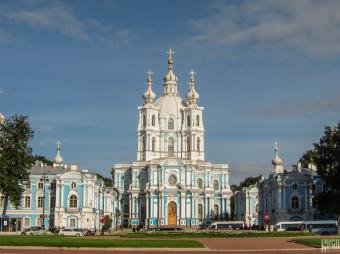
Smolny Convent
- 1 Ploschad Rastrelli
- Chernyshevskaya
- http://eng.cathedral.ru/
- 10:30 - 18:00. Closed on Wednesdays.
In the 1740s Empress Elizabeth ordered the construction of a convent on the site of the Smolny House where she spent her younger years. Her original intention was to retire to the convent in her later years. The convent is centred around the elegant Smolny Cathedral which is dedicated to the Resurrection of Christ. Work on the cathedral started in 1746 but was halted due to the war with Prussia. It was designed by Bartolomeo Rastrelli in the Elizabethan baroque style, but the later… Read more »
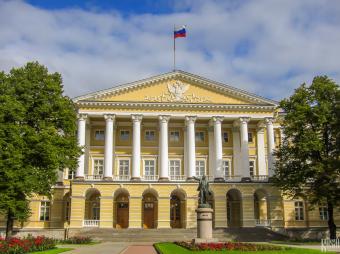
Smolny Institute (City Administration)
- 2 Alleya Smolnogo.
- Chernyshevskaya
The Smolny Institute was founded as the Smolny Institute for Noble Maidens (ie a finishing school) in 1764 by Empress Catherine the Great next to the Smolny Convent. Work on its main building was started in the 1790s and finished in 1806. It consists of a classical style building featuring a façade decorated with columns. In 1917 Lenin took over the building and used it as his headquarters up until the capital was moved back to Moscow. The building then became the headquarters of… Read more »
Tauride Palace and Gardens
- Ulitsa Kirochnaya
- Chernyshevskaya
Located on the western edge of the area of St Petersburg known as Peski, between Ulitsa Shpalernaya and Ulitsa Kirochnaya, is the Tauride Palace and its gardens. Tauride Palace The Tauride Palace was built between 1783 and 1789 in the classical style on the orders of Prince Grigori Potyomkin - a favourite of Empress Catherine the Great. It gets its name from the prince, who was assigned the name Tavrichesky ('of Tauride') by Catherine due to his role in adding Crimea to the… Read more »
Water Museum
- 56 Ulitsa Shpalernaya
- Chernyshevskaya
- http://www.vodokanal-museum.ru/
- 10:00 - 19:00. Closed on Mondays and Tuesdays.
The Universe of Water Museum was opened in 2003 in the city's first water tower which dates from the mid-19th century. Today they tower has been converted into an exhibition hall with displays on the history of the waterworks and canals of St Petersburg, after all water has played a big role in the formation of the city known as Venice of the North. In addition to this main exhibition there are also two multimedia exhibitions which can be visited as part of a tour. The… Read more »